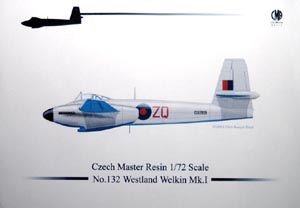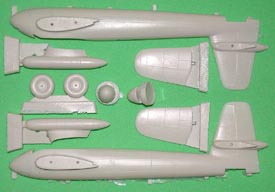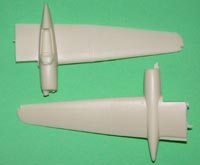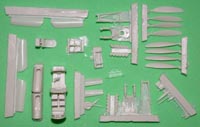Czech Master Resin 1/72 Westland Welkin |  |
Overview
First, I want to thank Chris for the opportunity to review this kit. This is second review I’ve done for him, and the same goes for this manufacturer. When I was offered the opportunity to do this review I was rather excited, any chance to build something British is a good one. But I must admit that I knew very little about this aircraft. According to the only source of info I have, “The Secret Years” by Tim Mason, the Welkin was Westland’s answer to the scourge of high altitude German bombers and reconnaissance aircraft over England. Ten Welkins flew at Boscombe Down, five of which crashed-four beyond repair. The prototype, DG558, arrived at Boscombe in May 1943 with Merlin 77 engines with two stage superchargers. Trials were delayed by the tail wheel collapsing shortly after arrival, and a forced landing following an engine seizure resulting from an over speeding. DG558 was further extensively damaged on return to Westland in September of that year. Maintenance was complex, but access was easy; in the air the plane had a lot of flaws, the most serious was engine fire. One of two production Welkins, DX278 caught fire and was completely burned out. A replacement Welkin, DX282 force landed a few days after arriving at Boscombe when the port engine over sped. DX282 would later be written off in a wheels up landing due to oil loss. Meanwhile Welkin DX280 was burnt out due to an engine failure and forced landing. DX279 exhibited some unfavorable flight characteristics including slow aileron response, rudder oscillation when its trim tab was deflected in asymmetrical flight, and some rather alarming elevator behavior on dive recoveries from high altitude. Needless to say, this aircraft was never put into extensive production as the RAF was leaning toward the more conventional Spitfire Mk IX.  The Kit The Kit
The best way to explain how the Welkin looks is that it’s a Westland Whirlwind on some serious steroids. It is BIG, a single seat fighter with a narrow chord wing the size of a Mosquito! The first thing you see when presented with the kit is another one of Chris’ lovely illustrations, good enough to matte and frame. The moldings are contained in sealed, compartmentalized plastic bags in a zip lock bag. This company should consider putting their kits in a box as delicate resin parts  are at risk of some serious damage. The castings are absolutely immaculate with finely engraved detail and a minimum of flash. The casting blocks are not too outrageous, and there are small casting lugs on the hollow cast fuselage to remove. Detail in the cockpit is finely raised and absolutely gorgeous. A nice little touch is locating holes in the fuselage and pins in the flying surfaces to facilitate accurate location, though I will probably replace the fragile pins with metal ones. All in all, a very lovely kit indeed. are at risk of some serious damage. The castings are absolutely immaculate with finely engraved detail and a minimum of flash. The casting blocks are not too outrageous, and there are small casting lugs on the hollow cast fuselage to remove. Detail in the cockpit is finely raised and absolutely gorgeous. A nice little touch is locating holes in the fuselage and pins in the flying surfaces to facilitate accurate location, though I will probably replace the fragile pins with metal ones. All in all, a very lovely kit indeed.  The instructions consist of logical exploded drawings that are quite clear and provide some basic color recommendations along the way. There are four view drawings for the two schemes provided in the kit complete with FS 595A numbers. An added feature is two double-sided pages of Welkin photos from Fred Ballam, the Westland Archivist. The instructions consist of logical exploded drawings that are quite clear and provide some basic color recommendations along the way. There are four view drawings for the two schemes provided in the kit complete with FS 595A numbers. An added feature is two double-sided pages of Welkin photos from Fred Ballam, the Westland Archivist.
The decals are quite lovely, matte with no visible carrier film. Two schemes are provided, DG558 the prototype, in dark earth, dark green upper surface with trainer  yellow underside, and DX289 of the Flight Interception Unit in 1944. DX289 is in the high altitude scheme of medium sea gray upper surface and PRU blue underside. DX289 is the scheme Chris rendered for the front card. yellow underside, and DX289 of the Flight Interception Unit in 1944. DX289 is in the high altitude scheme of medium sea gray upper surface and PRU blue underside. DX289 is the scheme Chris rendered for the front card. Conclusion Overall, a lovely model of a very obscure British design that was quite attractive design that defied the saying that if it looks good, it is good. | 









|
